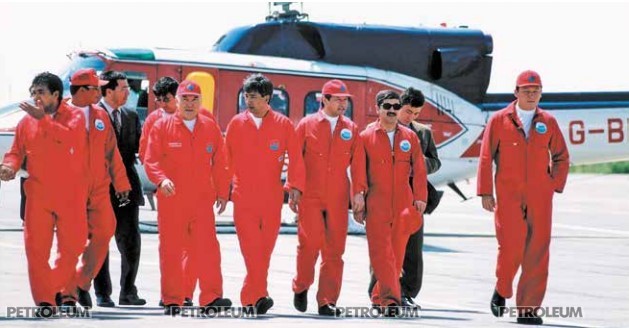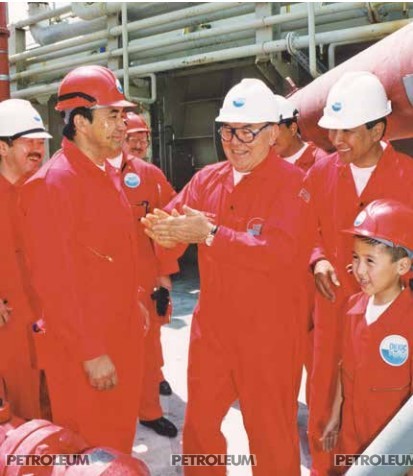Exclusive
Geologists are Creative in Naming the Offshore Discoveries
Ryan Halliwell and PetroleumIt is not enough to open a hydrocarbon field; we should also give it a name, which will bring the good luck. What are the principles of choosing a name for the fields? Journalist Ryan Halliwell from the Houston Chronicle newspaper analyzed, how it happens in the world. And in its turn, the Petroleum Journal did the same in Kazakhstan.
 President Nazarbayev arrived to attend the opening of Kashagan
President Nazarbayev arrived to attend the opening of Kashagan
Employees of LLOG Exploration Co. like the movie Animal House, so when they discovered an oil field at the depth of more than 18,000 feet below the sea floor in 2012, it made sense to name it after Bluto, the foul-mouthed degenerate, played by John Belushi in the comedy of 1978. Nearby, another discovery got similar treatment. It was named in honour of Marmalard, the neat leader of the group, rivalling with Bluto. And what’s up with the floating platform that will start producing oil the next year? It was named as Delta House, after the home of unsociable brothers. “It is a very serious business,”- said Eric Zimmerman, Vice President for Geology at the Covington (Louisiana),-but it’s a place where we all can have some fun”.
The above-mentioned is not the only unusual names in the portfolio of LLOG offshore fields. One of the largest assets, located in the west of the Animal House characters is called Who Dat, in honour of a chant, sang out by the fans of the New Orleans Angels football team. "Most of us are the natives of Louisiana,"- Zimmerman said. "We've been the fans of the Angels". Indeed, across the Gulf of Mexico, the energy companies give the oil fields the names, varying from smart and creative to completely bizarre ones.
BHP Billiton company is expecting the hordes of production from its Genghis Khan field. Shell hopes that its Habanera field will fulfil the uttermost expectations. And BP’s assets include the Mad Dog.
The names are the part of a decades-old tradition across the industry. In almost any oil company, it's not the marketing department or the executives, who decide how to name an offshore oil field. It is the business of a geologist who discovered it. "This is a privilege of those involved in hard work to develop the prospects," said John Shepard, manager of Latin America exploration at Shell Oil Co., who previously worked on Gulf of Mexico projects. "It's a great example of using “bottom -up”, rather than “top down” principle"
Shell keeps naming the offshore fields, being inspired by the cow breeds (Guernsey, Holstein, Angus), the cartoon characters (Popeye, Bullwinkle, Rocky) and even the famous physicists (Bohr, Kepler, Coulomb). The names can be even trickier. One of BP top projects in the Gulf of Mexico is calledNa-Kika, after the octopus god of the Gilbert Islands.
Some geologists choose names that rock.
Hess Corp. has a development called Tubular Bells, named after the debut album of English rocker Mike Oldfield, though it's a relatively new field, discovered 30 years after 1973 album release. Chevron's "Blind Faith" is a reference to Eric Clapton's band.
The naming tradition serves important functions beyond indulging the whims of the people who discover the oil. “Onshore, the oil fields are typically named after nearby geographic features like towns or streams”, -said Justin Devery, deep-water analyst, Gulf of Mexico area, working for IHS, who previously worked as a geologist at Unocal Corp.
 A boy from Adai tribe was symbolically marked by oil
A boy from Adai tribe was symbolically marked by oilUseful coding
That doesn't really work in an open ocean.
The development site maps, referring to the federal territory, are defined by the locations of the offshore oil fields, but they are designated according to the barren style of the government officials. Who Dat, for example, is located in blocks 503, 546 and 547 of an area. known as Mississippi Canyon. The oil companies prefer the legend that is easy to pronounce. The names also can serve as a code to prevent the rivals from overhearing the exact spot where a company is considering purchasing a federal drilling lease. "If someone happens to overhear several of us talking about the 'Rover' prospect, they have no idea what we're talking about," Shepard said.
Shepard, who worked for Shell since 1980, said the company originally used the letters and numbers as a code to mask the location of prospects it was considering. But it quickly become a burden. The first prospect he worked at was known simply as P-471. "I think they found the code numbers were almost as hard to remember as the block numbers they're referring to," -he said.
In the earlier days of offshore exploration, the names of formations were often based on simple themes, like the shark species (Great White, Maco, Tiger), tools (Auger, Machete, Screwdriver) or the titles (Queen, King, Princess). Generally, the leases in close proximity or purchased at one time followed a single topic. But as the industry used up the simplest themes, geologists had to get more creative.
Sometimes they chose names, reflecting their interests or hobbies. Shell has a group of prospects in the eastern Gulf of Mexico named after the Civil War sites, including Vicksburg, Gettysburg and Appomattox. “Ted Godo, Shell geologist who participated in discovering, is a fan of all things, related to the Civil War”,- says Shepard.



